An overview of the group's research into active plasmonics.
An enormous advantage of plasmonics is that they produce colours arising from nanometre scale gaps. Changing their nanostructure can thus produce ultrafast control to switch light.
Current Work
| |
 Actuating nano transducers Actuating nano transducers
Tiny charged particles of gold, are coated with a temperature-responsive polymer (pNIPAM) in the form of a gel. When these 'nano-engines' are heated above temperature of 32Cwith a laser, they store large amounts of elastic energy in a fraction of a second, as the polymer coatings expel all the water from the gel and collapse. This has the effect of forcing the gold nanoparticles to bind together into tight clusters (dramatically changing their colour). But when the engines are cooled, the polymers instantly absorb water and expand, so the gold nanoparticles are strongly and quickly pushed apart, like a spring. This produces the larges forces yet seen on the nanoscale, which we are looking to harness for building nanomachines.
Key paper: Ding et al., PNAS (2016); DOI: 10.1073/pnas.1524209113
|
| |
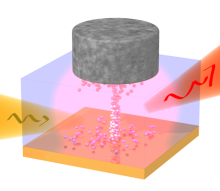 Studying resistive switches with light Studying resistive switches with light
Resistive switching memories (RRAMs) are non-volatile memory cells based on the fact that special types of insulator start to conduct if a high voltage is applied. A very small wire can be formed in the gap between the two electrodes of a cell by a current pulse applied across the electrodes, resulting in a vast reduction of the resistance. How the filament is created and what are the dynamics involved are still open questions. We use plasmon-enhanced light-matter interactions to studying in real time the movements of individual atoms, and consequently the morphological changes occurring in these novel memory nano-devices.
Key paper: Di Martino et al., Small 12, 1334 (2016)
|
| |
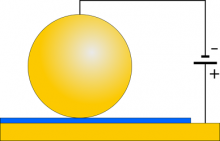
Biased plasmonics
Plasmonics is based on the oscillation of charges in a metal. We are developing techniques to add and subtract charges by applying an external voltage to metallic nanostructures, exploring the effects this has on the plasmonic behaviour of the system.
|
| |
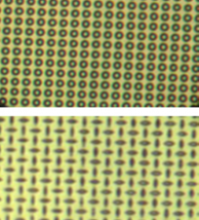
Buckling film plasmonic metamaterials
The structural transformation due to buckling instabilities in elastomeric substrates is being exploited to actively control the optical properties of nanostructured gold-polymer hybrid materials. We design patterned environmentally-responsive hydrogel sheets that exhibit a reversible shape transformation via polymer swelling. This provides a novel platform for the active tuning of the surface plasmonic response, which can lead to the fabrication of optomechanic switches or new assembly tools.
|
Previous Work
| |
 stretchable plasmonics stretchable plasmonics
Because plasmons have colours which exquisitely depend on nm-scale distances, combining metals with soft elastic materials allows us to create plasmonic devices which can be deformed to change colours.
|
| |
 quantum plasmonics quantum plasmonics
When two metal particles approach closer than 1nm, the quantum tunnelling of electrons from one to another starts to change the plasmonics. By developing a new way of measuring the colour of light in such nano-gaps, we show directly how quantum tunneling changes optics.
|
| |
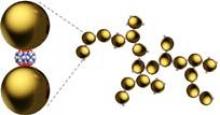 precise nanoaggregate plasmonics precise nanoaggregate plasmonics
The coupling between plasmonic nanoparticle becomes immense when their separation reduces to nanometres. However it has been previous difficult to control this gap, either using fabrication technology or chemistry. We use a cucurbituril molecule shaped like a barrel and exactly 0.9nm long to glue together Au nanoparticles, giving a completely precise sort of nanoplasmonics.
Some of this work has been carried out as part of the cubiholes project.
|
References
[5] “Surface-Enhanced Coherent AntiStokes Raman Scattering on Nanostructured Au Surfaces”, Nano Lett 11, 5339 (2011)
[4] “From microns to kissing contact: dynamic positioning of two nanosystems”, App.Phys.Lett. 99, 053110 (2011)
[3] “Precise sub-nm plasmonic junctions within Au nanoparticle assemblies using CB glue”, ACS Nano 5, 3878 (2011)
[2] “Enhancing Solar Cells with Localised Plasmons in NanoVoids”, Opt. Exp. 19, 11256 (2011)
[1] “Dressing Plasmons in Particle-in-Cavity Architectures”, Nano Letters 11, 1221 (2011)
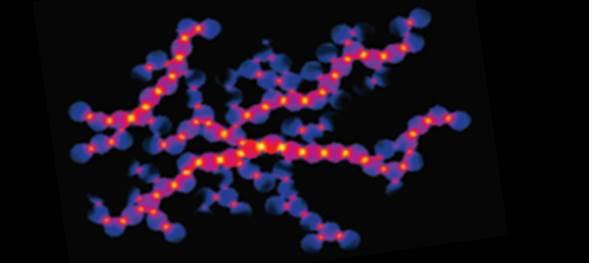






 stretchable plasmonics
stretchable plasmonics quantum plasmonics
quantum plasmonics precise nanoaggregate plasmonics
precise nanoaggregate plasmonics